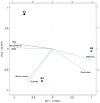Electrospun Nanofibers with Pomegranate Peel Extract as a New Concept for Treating Oral Infections
- PMID: 38893822
- PMCID: PMC11173823
- DOI: 10.3390/ma17112558
Electrospun Nanofibers with Pomegranate Peel Extract as a New Concept for Treating Oral Infections
Abstract
Pomegranate peel extract is known for its potent antibacterial, antiviral, antioxidant, anti-inflammatory, wound healing, and probiotic properties, leading to its use in treating oral infections. In the first stage of this work, for the first time, using the Design of Experiment (DoE) approach, pomegranate peel extract (70% methanol, temperature 70 °C, and three cycles per 90 min) was optimized and obtained, which showed optimal antioxidant and anti-inflammatory properties. The optimized extract showed antibacterial activity against oral pathogenic bacteria. The second part of this study focused on optimizing an electrospinning process for a combination of polycaprolactone (PCL) and polyvinylpyrrolidone (PVP) nanofibers loaded with the optimized pomegranate peel extract. The characterization of the nanofibers was confirmed by using SEM pictures, XRPD diffractograms, and IR-ATR spectra. The composition of the nanofibers can control the release; in the case of PVP-based nanofibers, immediate release was achieved within 30 min, while in the case of PCL/PVP, controlled release was completed within 24 h. Analysis of the effect of different scaffold compositions of the obtained electrofibers showed that those based on PCL/PVP had better wound healing potential. The proposed strategy to produce electrospun nanofibers with pomegranate peel extract is the first and innovative approach to better use the synergy of biological action of active compounds present in extracts in a patient-friendly pharmaceutical form, beneficial for treating oral infections.
Keywords: anti-inflammatory; antibacterial; nanofibers; oral infections; pomegranate peel; wound healing.
Conflict of interest statement
Author Jakub Kwiatek was employed by the company Kwiatek Dental Clinic Sp. z o.o. Author Michał Walendowski was employed by the company Science-Bridge Sp. z o.o. The remaining authors declare that the research was conducted in the absence of any commercial or financial relationships that could be construed as a potential conflict of interest.
Figures










References
-
- Oral Health. [(accessed on 19 April 2024)]. Available online: https://www.who.int/news-room/fact-sheets/detail/oral-health.
-
- Amato M., Santonocito S., Polizzi A., Tartaglia G.M., Ronsivalle V., Viglianisi G., Grippaudo C., Isola G. Local Delivery and Controlled Release Drugs Systems: A New Approach for the Clinical Treatment of Periodontitis Therapy. Pharmaceutics. 2023;15:1312. doi: 10.3390/pharmaceutics15041312. - DOI - PMC - PubMed
Grants and funding
LinkOut - more resources
Full Text Sources
Molecular Biology Databases
Miscellaneous

